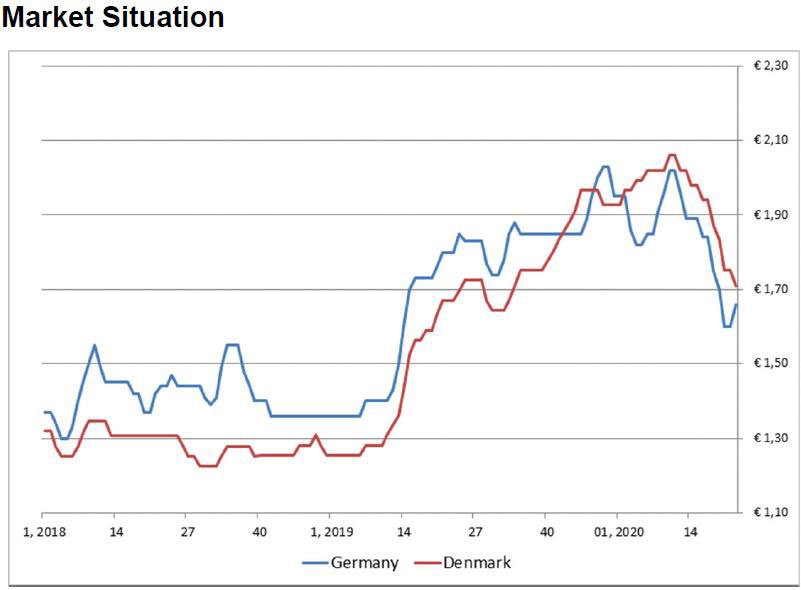Country Report Denmark
Market Situation
Since the fall of 2019 the Danish slaughter pig price has been ahead of the German one, which is unusual (see graph).The whole market situation has changed,primarily because the Danish export for Asia is notably higher than the German one and furthermore, the Danish export to Asia has also increased significantly. As mentioned in the previous EPP report Danish Crown last year launched their initiative of providing 200m DKK as loans to Danish pig producers with the purpose of establishing slaughter pig units. Evaluating the initiative shows that only one pig producing unit with 1,000 pen places has been established. We presume that the reason for the lacking use of the initiative is that at the moment the financial sector provides pig producers with other financing opportunities due to the relatively high pig prices. However, we have seen a rise in slaughter pig production during the first months of 2020 while the export of weaners has stagnated. Thus, though pig producers have not made use of Danish Crown’s financing initiative, it seems that Danish Crown to some extent have succeeded in keeping more weaners in Denmark.
Political Situation
The heavier control regarding transported animals will continue until 1 July 2020. The initiative will result in anextra cost of 3 DKK per exported weaner. We still haven’t heard the government, nor the minister of food and agriculture talk about an evaluation of the control although that was promised by the former government, whointroduced the heavier control. We have taken out a summons against the minister of food and agriculture regarding the heavier control imposed on those who export their weaners.Another matter concerning transport is that The Danish Veterinary and Food Administration (DVFA) has sentout a hearing request according to which – if decided – deck heights in road vehicles must be changed by 1 July 2020 with the objective of providing more space for weaners and hence more animal welfare. The changes are so comprehensive that it would be completely impossible to meet the requirements in due time for the deadline. It is also evident that the haulage contractors’ financial losses have been completely disregarded and that the proposal will have catastrophic influence on small and middle-sized haulage contractors. Therefore, we (Danske Svineproducenter) have submitted our response to the hearing request pinpointing the lack of calculating the consequences of the proposal and – which is just as important – that problems with animal welfare in weaners during transport is so far undocumented as well as the claim that the new requirements regarding deck height will improve animal welfare during transport. It is our assessment that the domestic transport will result in an extra need of road vehicles of 20 percent and that e.g. a pig producer exporting 30,000 weaners will have an extra cost of 450,000 to 650,000 DKK (approx. 60,000 to 87,000 EUR). Recently, soy has become a political topic and is heavily debated by politicians and various industries, not to mention consumers. The overall political aim is that soy production must be sustainably produced and not imported from deforestation areas. Paradoxically, Danish Crown (which is owned by farmers) now promise on behalf of their owners that only sustainably produced soy is used in animal production – despite the fact that sustainable soy is already being used through the joint European certification FEFAC. Regarding PRRS an outbreak took place last summer in a service station which delivered semen to 40 different pig producing units that were infected. They have now commenced legal proceedings in terms of approx.

